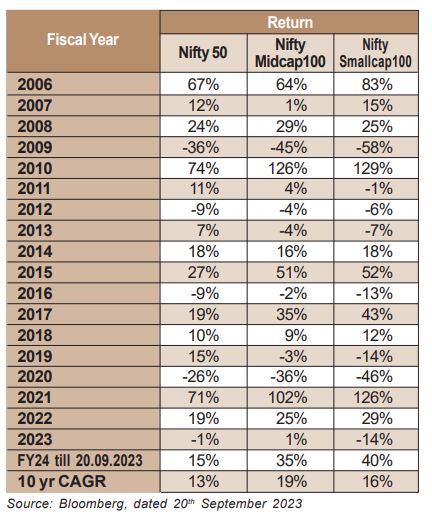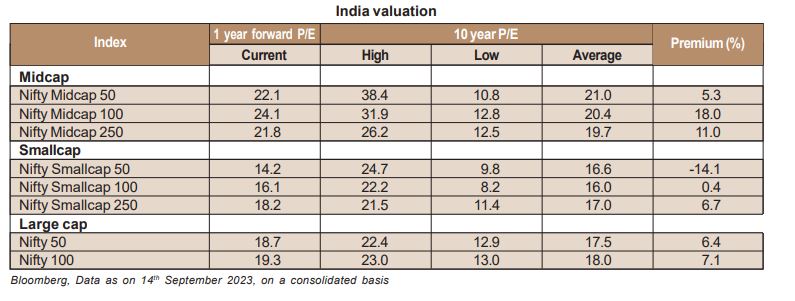As forecasted, it seems that the market is entering a phase of short-term correction. We anticipate this to be a transitory trend and want to stress that the concerns currently associated with mid- and small-cap stocks in the market are somewhat excessive. While it’s possible that the correction has just begun and may continue for the near term, investors need not react with undue alarm. The underlying factors contributing to this situation are a robust domestic economy and a sustained corporate earnings cycle, both of which are on a positive long-term trajectory.
While certain pockets of the market may appear overextended, overall large and small-cap stocks are trading within reasonable range. The major concern, however, stems from the global market turmoil, which has potential implications for emerging markets and the possibility of a slowdown in foreign capital inflows. Selling by FIIs is the main factor affecting the domestic market trend while DIIs and retail inflows continue to be healthy. Even in the ongoing downtrend, India is outshining due to relatively restrained selling by FIIs and stable domestic inflows.
A prominent concern now revolves around the unexpected performance of mid and small-cap stocks, and the perception that they might be vulnerable to a correction. Many missed the rally. However, we would like to emphasize that the long-term positive trend has only just begun. The primary catalysts for mid and small-cap stocks are quality and storyline. In a diverse basket of stocks, there will inevitably be a mix of good and bad stocks. The potential of domestic mid-caps to flourish has risen due to the emergence of India as a key player in the global supply chain, a resilient domestic economy (7% real GDP growth in the foreseeable future), and the phenomenal rise of domestic equity investment patterns.
New narratives are unfolding across various sectors, including technology, fintech, e-commerce, SaaS, biotech, education, semiconductors, IT hardware, chemicals, renewables, ethanol, and more. Each mid and small-cap stock’s trajectory is distinct, driven by its USP, products and management skills. The art of selecting the right stock is paramount. If your stock is fundamentally solid with a good business outlook, you don’t need to panic.
Enthusiasm of mid and small caps gets seemingly high
It is widely acknowledged that when mid and small cap stocks begin to gain momentum, enthusiasm can soar to great heights. Pinpointing the exact moment when this trend will shift from a positive rally to a negative one, and vice versa, is indeed a formidable challenge. The rally of mid and small caps in 2023 started only in the month of April. And it smartly rallied, leading to a return of 35% and 40% respectively as on 20th Sept 2023, leading to concerns that the category is overvalued.

It’s essential to recognize that this category had a relatively lackluster performance in FY23, with gains of just +1% and a decline of -14%, respectively. However, the recent rally has gathered substantial momentum over the past 5 to 6 months, bolstered by increased domestic investments and robust corporate earnings growth. These factors underline the core strengths of the market, which are anticipated to endure in the long term.
The up-trending investment pattern in India
During the July to September 2023 quarter, FIIs were significant net sellers in various Asian equity markets, including Japan, Indonesia, Thailand, Taiwan, and South Korea. This largely stems from their anticipation of an economic slowdown in Asia and increased volatility in the currency markets due to rising bond yields. India stands out as a shining spot in the world, which is grappling with various challenges. This trend is expected to persist in the long term, as India is increasingly establishing itself as a crucial player in the global supply chains and boasts a resilient domestic economy, with a projected 7% real GDP growth in the foreseeable future. Nevertheless, in the near term, given the turmoil in global markets, there could be potential repercussions for India as well.
However, the net influx into DIIs for equity schemes from retail/corporates reduced substantially in FY24. Inflow in MF equity schemes in April to June 2023 is at Rs 18,358 crore, 63% down compared to Rs. 49,917 crore in April to June 2022 (AMFI). Profit booking in large caps and a shift from equity to debt and hybrids were the trail. However, monthly SIP collection has increased to all-time highs, deflecting worries.
All-time high SIP
Concurrently, there has been a substantial 50% increase in inflows into Mid and Small-cap portfolios, amounting to Rs. 15,670 crore. Likewise, there has been notable buying activity at the retail desk, including HNIs, contributing to a vibrant April to September period. In the short-term, we can expect profit booking in the mid and small caps category with funds potentially shifting into large caps and other asset classes. However, the continuation of a rising SIP culture and a strong earnings growth outlook will sustain growth in mid and small caps.

Strong corporate earnings
In India, corporate earnings have shown considerable growth in Q1FY24, driven by steady demand from both domestic and external economies and a substantial reduction in input costs. This positive trend in profit margins is expected to further broaden in the second quarter, as commodity prices have continued to stabilize, and demand remains steady. Nifty50 index stocks showcased a consolidated PAT growth of +30% in Q1, while Mid and Small cap stocks were at +25%.
Earnings growth is foreseen to be healthy in H1FY24. Although some margin moderation may occur in the third quarter due to rising input costs, such as crude oil prices exceeding $90 per barrel, strong demand is anticipated to persist. This expectation is supported by various indicators, including the PMI, increasing capacity utilization, and positive management commentary. Seasonally, the Indian economy generates about 53% of the economy’s activities in H2.
We anticipate the mid and small cap categories to reap the full benefit with a lag in the coming quarters. The market expects Nifty 50’s earnings growth to be in the range of 15% to 20% in FY24, with a substantial multiplier effect on the mid and small cap category’s earnings growth.
Valuations are not at bubble levels

Strong earnings often translate to robust valuations. It’s clear that India is poised to command a premium, with a valuation just 6% above the long-term average, suggesting there is more room for growth. But the near-term issue is the performance of world equity. Nevertheless, we need not be concerned, and the key trigger of earnings growth is sustained. Though midcap’s premium is on the higher side, in the case of small caps it’s still accommodative. The best 50 small cap index is trading at a 14% discount, indicating that we are not in a bubble.
It is indeed possible that the strong performance of the past 6 months may prompt some profit booking in the short term. Nonetheless, in a growing economy with vast opportunities for the emergence of new clusters of businesses and expansion, the outlook remains stable for mid and small caps. Especially, if these stocks possess strong fundamentals and operate in sectors poised for development, their prospects are likely to remain promising. Midcap stocks often trade at high valuations during bullish cycles. Determining when the trend will shift from positive to negative and vice versa is challenging. The only viable approach is to consistently monitor the company’s growth trajectory and industry dynamics, forecast long-term financial metrics, and conduct thorough risk assessments to make informed decisions regarding buying, holding, or selling stocks. Capitalise from the ongoing correction as India is in a long-term direction. Identify your picks of high quality and firm storylines, and use buy on dips as a strategy.







